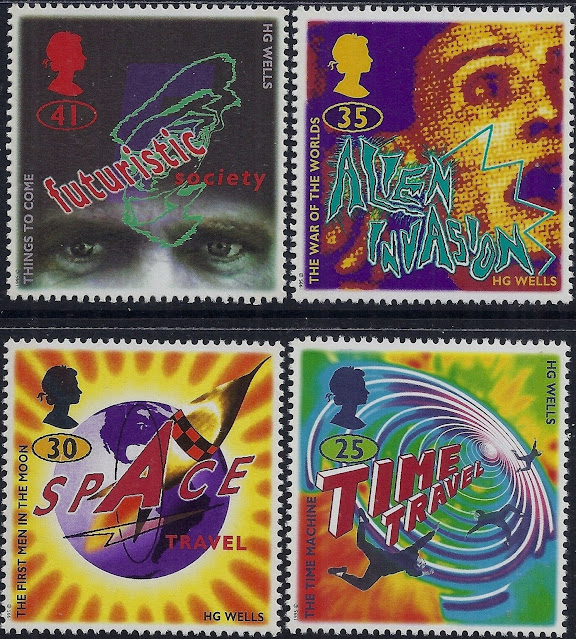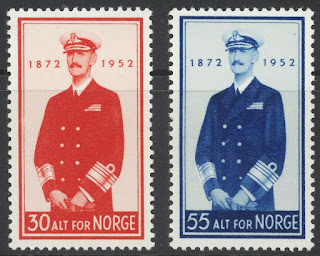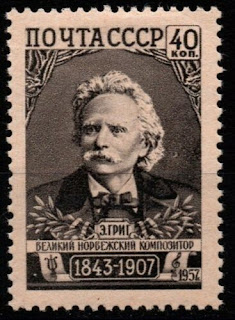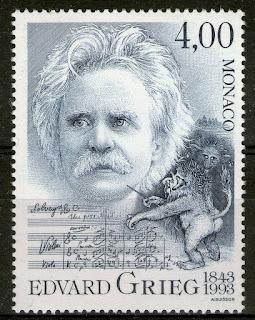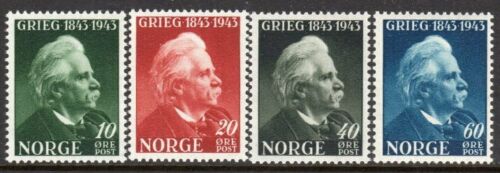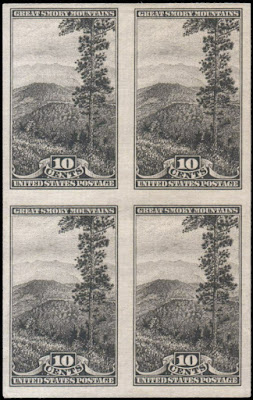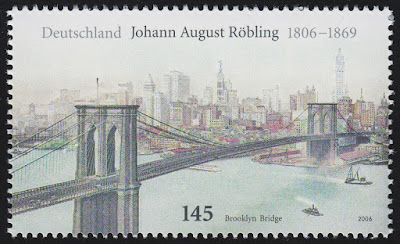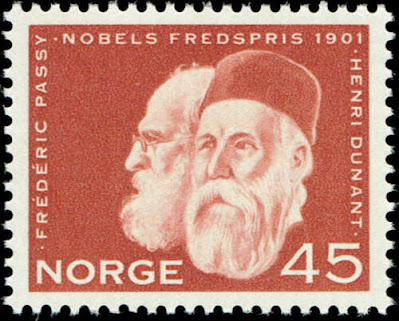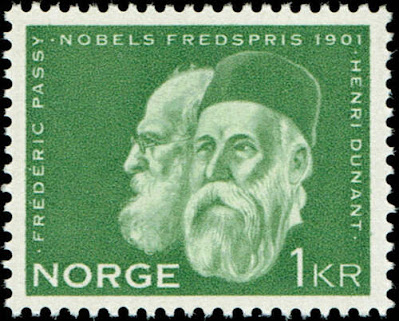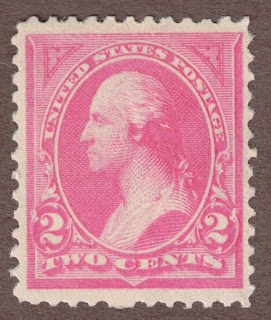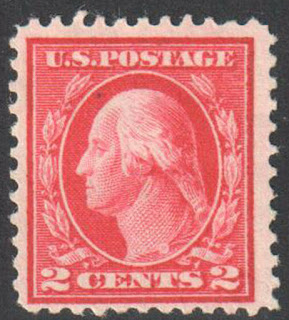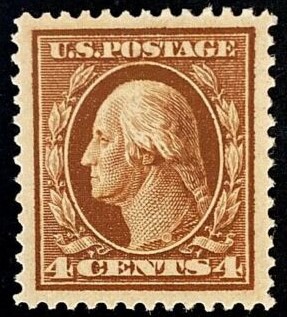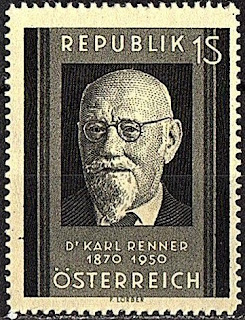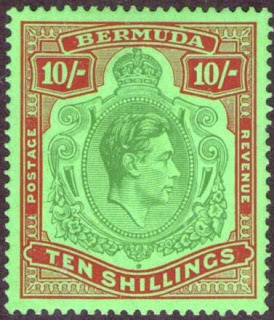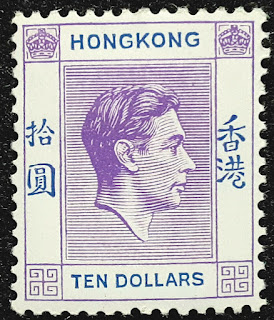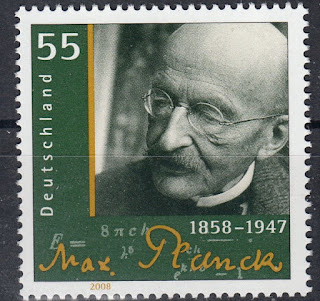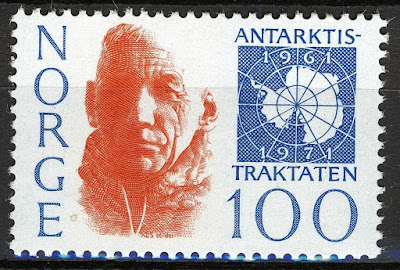Monday, September 21, 2020
September 21st in stamps Arthur Schopenhauer, H. G. Wells, Haakon VII of Norway
Monday, August 03, 2020
August 3rd in stamps Ivan Zajc, Haakon VII, Solzhenitsyn
Monday, June 15, 2020
June 15th in stamps Edvard Grieg, Kaiser Wilhelm II, Great Smoky Mountains National Park
The eldest grandchild of Queen Victoria, Wilhelm's first cousins included King George V of the United Kingdom and many princesses who, along with Wilhelm's sister Sophia, became European consorts. For most of his life before becoming emperor, he was second in line to succeed his grandfather Wilhelm I on the German and Prussian thrones after his father, Crown Prince Frederick. His grandfather and father both died in 1888, the Year of Three Emperors, making Wilhelm emperor and king. He dismissed the country's longtime chancellor, Otto von Bismarck, in 1890.
Upon consolidating power as emperor, Wilhelm launched Germany on a bellicose "New Course" to cement its status as a respected world power. However, he frequently undermined this aim by making tactless, alarming public statements without consulting his ministers. He also did much to alienate his country from the other Great Powers by initiating a massive build-up of the German Navy, challenging French control over Morocco, and backing the Austrian annexation of Bosnia in 1908. His turbulent reign ultimately culminated in his guarantee of military support to Austria-Hungary during the crisis of July 1914, resulting in the outbreak of World War I. A lax wartime leader, he left virtually all decision-making regarding military strategy and organisation of the war effort in the hands of the German General Staff. This broad delegation of authority gave rise to a de facto military dictatorship whose belligerent foreign policy led to the United States' entry into the war on April 6, 1917. After losing the support of the German military and his subjects in November 1918, Wilhelm abdicated and fled to exile in the Netherlands, where he died in 1941.
Stamp issued by Germany depicting Wilhelm II
Postcard depicting Wilhelm II
Friday, June 12, 2020
June 12th in stamps Helsinki, Roebling Brooklyn Bridge, Karl von Drais dandy horse, Frédéric Passy
1550 – The city of Helsinki, Finland (belonging to Sweden at the time) is founded by King Gustav I of Sweden.
Helsinki is the capital and most populous city of Finland. Located on the shore of the Gulf of Finland, it is the seat of the region of Uusimaa in southern Finland, and has a population of 650,058. The city's urban area has a population of 1,268,296, making it by far the most populous urban area in Finland as well as the country's most important center for politics, education, finance, culture, and research. Helsinki is located 80 kilometres (50 mi) north of Tallinn, Estonia, 400 km (250 mi) east of Stockholm, Sweden, and 300 km (190 mi) west of Saint Petersburg, Russia. It has close historical ties with these three cities.
Together with the cities of Espoo, Vantaa, and Kauniainen, and surrounding commuter towns, Helsinki forms the Greater Helsinki metropolitan area, which has a population of nearly 1.5 million. Often considered to be Finland's only metropolis, it is the world's northernmost metro area with over one million people as well as the northernmost capital of an EU member state. After Stockholm and Oslo, Helsinki is the third largest municipality in the Nordic countries. Finnish and Swedish are both official languages. The city is served by the international Helsinki Airport, located in the neighboring city of Vantaa, with frequent service to many destinations in Europe and Asia.
Helsinki was the World Design Capital for 2012, the venue for the 1952 Summer Olympics, and the host of the 52nd Eurovision Song Contest in 2007.
Helsinki has one of the world's highest urban standards of living. In 2011, the British magazine Monocle ranked Helsinki the world's most liveable city in its liveable cities index. In the Economist Intelligence Unit's 2016 liveability survey, Helsinki was ranked ninth among 140 cities.
Stamps issued in 1950 for the 400 year anniversary of the founding of Helsinki
1806 Born: John A. Roebling, German-American engineer, designed the Brooklyn Bridge (d. 1869)
John Augustus Roebling (born Johann August Röbling; June 12, 1806 – July 22, 1869) was a German-born American civil engineer. He designed and built wire rope suspension bridges, in particular the Brooklyn Bridge, which has been designated as a National Historic Landmark and a National Historic Civil Engineering Landmark.
The Brooklyn Bridge is a hybrid cable-stayed/suspension bridge in New York City, spanning the East River between the boroughs of Manhattan and Brooklyn. Opened on May 24, 1883, the Brooklyn Bridge was the first fixed crossing across the East River. It was also the longest suspension bridge in the world at the time, with a main span of 1,595.5 feet (486.3 m) and a deck height of 127 ft (38.7 m) above mean high water. The span was originally called the New York and Brooklyn Bridge or the East River Bridge but was officially renamed the Brooklyn Bridge in 1915.
Proposals for a bridge connecting Manhattan and Brooklyn were first made in the early 19th century, which eventually led to the construction of the current span, designed by John A. Roebling. His son Washington Roebling oversaw the construction and contributed further design work, assisted by the latter's wife, Emily Warren Roebling. While construction started in 1870, numerous controversies and the novelty of the designed construction process caused the actual construction to be prolonged over thirteen years. Since opening, the Brooklyn Bridge has undergone several reconfigurations, having carried horse-drawn vehicles and elevated railway lines until 1950. To alleviate increasing traffic flows, additional bridges and tunnels were built across the East River. Following gradual deterioration, the Brooklyn Bridge has been renovated several times, including in the 1950s, 1980s, and 2010s.
The Brooklyn Bridge is the southernmost of four toll-free vehicular bridges connecting Manhattan Island and Long Island, with the Manhattan, Williamsburg, and Queensboro bridges to the north. Only passenger vehicles and pedestrian and bicycle traffic are permitted. A major tourist attraction since its opening, the Brooklyn Bridge has become an icon of New York City. Over the years, the bridge has been used as the location of various stunts and performances, as well as several crimes and attacks. The Brooklyn Bridge has been designated a National Historic Landmark, a New York City landmark, and a National Historic Civil Engineering Landmark.
Stamps and First Day Cover issued in 2006 by Germany to commemorate John Augustus Roebling
US First Day Cover issued for the 100th year anniversary of the opening of the Brooklyn Bridge
1817 – The earliest form of bicycle, the dandy horse, is driven by Karl von Drais.
Karl Freiherr von Drais (full name: Karl Friedrich Christian Ludwig Freiherr Drais von Sauerbronn) (29 April 1785 in Karlsruhe – 10 December 1851 in Karlsruhe) was a noble German forest official and significant inventor in the Biedermeier period.
Drais was a prolific inventor, who invented the Laufmaschine ("running machine"), also later called the velocipede, draisine (English) or draisienne (French), also nicknamed the hobby horse or dandy horse. This was his most popular and widely recognized invention. It incorporated the two-wheeler principle that is basic to the bicycle and motorcycle and was the beginning of mechanized personal transport. This was the earliest form of a bicycle, without pedals. His first reported ride from Mannheim to the "Schwetzinger Relaishaus" (a coaching inn, located in "Rheinau", today a district of Mannheim) took place on 12 June 1817 using Baden's best road. Karl rode his bike; it was a distance of about 7 kilometres (4.3 mi). The round trip took him a little more than an hour, but may be seen as the big bang for horseless transport. However, after marketing the velocipede, it became apparent that roads were so rutted by carriages that it was hard to balance on the machine for long, so velocipede riders took to the pavements and moved far too quickly, endangering pedestrians. Consequently, authorities in Germany, Great Britain, the United States, and even Calcutta banned its use, which ended its vogue for decades.
German stamp issued in 2017 for the 200th anniversary of the bicycle
Saturday, December 14, 2019
December 14th in stamps Quantum mechanics, Kitty Hawk, South Pole Expedition, Karl Rennen, George VI, Paul of Greece, George Washington
1799 Died: George Washington, American general and politician, 1st President of the United States (b. 1732)
George Washington (February 22, 1732 – December 14, 1799) was an American political leader, military general, statesman, and Founding Father who served as the first president of the United States from 1789 to 1797. Previously, he led Patriot forces to victory in the nation's War for Independence. He presided at the Constitutional Convention of 1787, which established the U.S. Constitution and a federal government. Washington has been called the "Father of His Country" for his manifold leadership in the formative days of the new nation.
Washington received his initial military training and command with the Virginia Regiment during the French and Indian War. He was later elected to the Virginia House of Burgesses and was named a delegate to the Continental Congress, where he was appointed Commanding General of the Continental Army. He commanded American forces, allied with France, in the defeat and surrender of the British during the Siege of Yorktown. He resigned his commission after the Treaty of Paris in 1783.
Washington played a key role in adopting and ratifying the Constitution and was then twice elected president by the Electoral College. He implemented a strong, well-financed national government while remaining impartial in a fierce rivalry between cabinet members Thomas Jefferson and Alexander Hamilton. During the French Revolution, he proclaimed a policy of neutrality while sanctioning the Jay Treaty. He set enduring precedents for the office of president, including the title "Mr. President", and his Farewell Address is widely regarded as a pre-eminent statement on republicanism.
Washington owned slaves, and, in order to preserve national unity, he supported measures passed by Congress to protect slavery. He later became troubled with the institution of slavery and freed his slaves in a 1799 will. He endeavored to assimilate Native Americans into Anglo-American culture, but combated indigenous resistance during instances of violent conflict. He was a member of the Anglican Church and the Freemasons, and he urged broad religious freedom in his roles as general and president. Upon his death, he was eulogized as "first in war, first in peace, and first in the hearts of his countrymen". He has been memorialized by monuments, art, geographical locations, stamps, and currency, and many scholars and polls rank him among the greatest U.S. presidents.
US Stamps depicting George Washington
1895 Born George VI of the United Kingdom (d. 1952)
George VI (Albert Frederick Arthur George; 14 December 1895 – 6 February 1952) was King of the United Kingdom and the Dominions of the British Commonwealth from 11 December 1936 until his death. He became known as a symbol of British determination to win the Second World War against Germany.
Known as "Bertie" among his family and close friends, George VI was born in the reign of his great-grandmother Queen Victoria and was named after his great-grandfather Albert, Prince Consort. As the second son of King George V, he was not expected to inherit the throne and spent his early life in the shadow of his elder brother, Edward. He attended naval college as a teenager, and served in the Royal Navy and Royal Air Force during the First World War. In 1920, he was made Duke of York. He married Lady Elizabeth Bowes-Lyon in 1923 and they had two daughters, Elizabeth and Margaret. In the mid-1920s, he had speech therapy for a stammer, which he never fully overcame.
George's elder brother ascended the throne as Edward VIII upon the death of their father in 1936. However, Edward was forced to choose between the crown and marriage to divorced American socialite Wallis Simpson. With the abdication of Edward to marry Simpson, George ascended the throne as the third monarch of the House of Windsor.
From 1939, the British Empire and Commonwealth – except Ireland – declared war on Nazi Germany. War with the Kingdom of Italy and the Empire of Japan followed in 1940 and 1941, respectively. The king and his family remained in London during the Blitz and his popularity soared as he shared the hardships of the common people. Britain and its allies were victorious in 1945, but the British Empire declined. Ireland had largely broken away, followed by independence of India and Pakistan in 1947. George relinquished the title of Emperor of India in June 1948 and instead adopted the new title of Head of the Commonwealth. He was beset by smoking-related health problems in the later years of his reign and died of coronary thrombosis in 1952. He was succeeded by his daughter, Elizabeth II.
Stamps from Bermuda, India, Hong Kong and Great Britain depicting George VI
1900 – Quantum mechanics: Max Planck presents a theoretical derivation of his black-body radiation law.
Max Karl Ernst Ludwig Planck (23 April 1858 – 4 October 1947) was a German theoretical physicist whose discovery of energy quanta won him the Nobel Prize in Physics in 1918.
Planck made many contributions to theoretical physics, but his fame as a physicist rests primarily on his role as the originator of quantum theory, which revolutionized human understanding of atomic and subatomic processes. In 1948, the German scientific institution the Kaiser Wilhelm Society (of which Planck was twice president) was renamed the Max Planck Society (MPS). The MPS now includes 83 institutions representing a wide range of scientific directions.
Some stamps from Germany, East Germany and Berlin depicting Max Planck
1901 Born: Paul of Greece (d. 1964)
Paul (Greek: Παύλος, Pávlos; 14 December 1901 – 6 March 1964) was King of Greece from 1947 until his death in 1964. He was succeeded by his son, Constantine II.
Paul was born at Tatoi Palace in Athens, the third son of King Constantine I of Greece and his wife, Princess Sophia of Prussia. He trained as an army officer at the Royal Military College, Sandhurst and later at the Hellenic Military Academy in Kypseli, Athens. Paul was an army officer cadet in the Coldstream Guards and Lieutenant with the Evzones.
Paul returned to Greece in 1946. He succeeded to the throne in 1947, on the death of his childless elder brother, King George II, during the Greek Civil War (between Greek Communists and the non-communist Greek government). In 1947 he was unable to attend the wedding of his first cousin, Prince Philip, Duke of Edinburgh to the future Queen Elizabeth II of the United Kingdom as he was suffering from typhoid fever.
By 1949 the Civil War was effectively over, with the Communist insurgents ceasing the majority of their operations, and the task of rebuilding the shattered north of the country began.
In the 1950s Greece recovered economically, and diplomatic and trade links were strengthened by Paul’s state visits abroad. He became the first Greek Monarch to visit a Turkish Head of State. However, links with Britain became strained over Cyprus, where the majority Greek population favored union with Greece, which Britain, as the colonial power, would not endorse. Eventually, Cyprus became an independent state in 1960.
In 1959, he had an operation for a cataract, and in 1963 an emergency operation for appendicitis. In late February 1964, he underwent a further operation for stomach cancer, and died about a week later in Athens. He was succeeded by his son, Constantine II.
1903 – The Wright brothers make their first attempt to fly with the Wright Flyer at Kitty Hawk, North Carolina.
The Wright Flyer (often retrospectively referred to as Flyer I or 1903 Flyer) was the first successful heavier-than-air powered aircraft. It was designed and built by the Wright brothers. They flew it four times on December 17, 1903, near Kill Devil Hills, about four miles (6.4 km) south of Kitty Hawk, North Carolina. Today, the airplane is exhibited in the National Air and Space Museum in Washington D.C. The U.S. Smithsonian Institution describes the aircraft as "the first powered, heavier-than-air machine to achieve controlled, sustained flight with a pilot aboard." The flight of Flyer I marks the beginning of the "pioneer era" of aviation.
Stamps issued by the US commemorating the first flight at Kitty Hawk
1911 – Roald Amundsen's team, comprising himself, Olav Bjaaland, Helmer Hanssen, Sverre Hassel, and Oscar Wisting, becomes the first to reach the South Pole.
Roald Engelbregt Gravning Amundsen 16 July 1872 – c. 18 June 1928) was a Norwegian explorer of polar regions and a key figure of the Heroic Age of Antarctic Exploration. He led the first expedition to traverse the Northwest Passage by sea, from 1903 to 1906, and the first expedition to the South Pole in 1911. He led the first expedition to fly over the North Pole in a dirigible 1926. He disappeared while taking part in a rescue mission for the airship Italia in 1928.
Amundsen planned to take an expedition to the North Pole and explore the Arctic Basin. Finding it difficult to raise funds, when he heard in 1909 that the Americans Frederick Cook and Robert Peary had claimed to reach the North Pole as a result of two different expeditions, he decided to reroute to Antarctica. He was not clear about his intentions, and Robert F. Scott and the Norwegian supporters felt misled. Scott was planning his own expedition to the South Pole that year. Using the ship Fram, earlier used by Fridtjof Nansen, Amundsen left Oslo for the south on 3 June 1910. At Madeira, Amundsen alerted his men that they would be heading to Antarctica, and sent a telegram to Scott: "Beg to inform you Fram proceeding Antarctic—Amundsen."
Nearly six months later, the expedition arrived at the eastern edge of the Ross Ice Shelf (then known as "the Great Ice Barrier"), at a large inlet called the Bay of Whales, on 14 January 1911. Amundsen established his base camp there, calling it Framheim. Amundsen eschewed the heavy wool clothing worn on earlier Antarctic attempts in favour of adopting Inuit-style furred skins.
Using skis and dog sleds for transportation, Amundsen and his men created supply depots at 80°, 81° and 82° South on the Barrier, along a line directly south to the Pole. Amundsen also planned to kill some of his dogs on the way and use them as a source for fresh meat. A small group, including Hjalmar Johansen, Kristian Prestrud and Jørgen Stubberud, set out on 8 September, but had to abandon their trek due to extreme temperatures. The painful retreat caused a quarrel within the group, and Amundsen sent Johansen and the other two men to explore King Edward VII Land.
A second attempt, with a team of five made up of Olav Bjaaland, Helmer Hanssen, Sverre Hassel, Oscar Wisting, and Amundsen, departed base camp on 19 October. They took four sledges and 52 dogs. Using a route along the previously unknown Axel Heiberg Glacier, they arrived at the edge of the Polar Plateau on 21 November after a four-day climb. The team and 16 dogs arrived at the pole on 14 December, a month before Scott's group. Amundsen named their South Pole camp Polheim. Amundsen renamed the Antarctic Plateau as King Haakon VII's Plateau. They left a small tent and letter stating their accomplishment, in case they did not return safely to Framheim.
The team arrived at Framheim on 25 January 1912, with 11 surviving dogs. They made their way off the continent and to Hobart, Australia, where Amundsen publicly announced his success on 7 March. He telegraphed news to backers.
Amundsen's expedition benefited from his careful preparation, good equipment, appropriate clothing, a simple primary task, an understanding of dogs and their handling, and the effective use of skis. In contrast to the misfortunes of Scott's team, Amundsen's trek proved relatively smooth and uneventful.
Stamps from Norway and Russia picturing Amundsen



